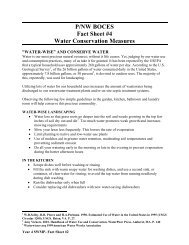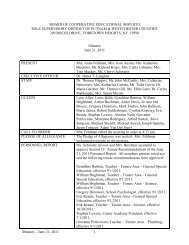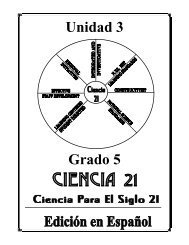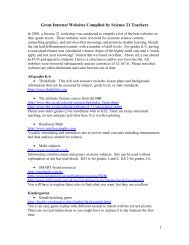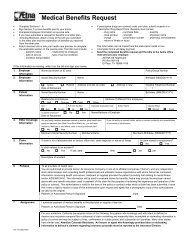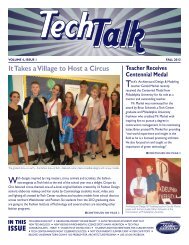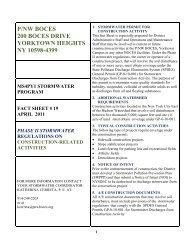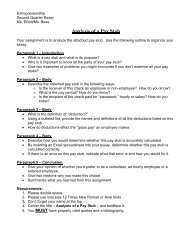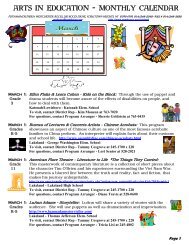Lesson 1 Fruit Loops Overview: This lesson was adapted ... - Boces
Lesson 1 Fruit Loops Overview: This lesson was adapted ... - Boces
Lesson 1 Fruit Loops Overview: This lesson was adapted ... - Boces
You also want an ePaper? Increase the reach of your titles
YUMPU automatically turns print PDFs into web optimized ePapers that Google loves.
Unit 6: Oh What a Tangled Web We Weave:<br />
Interdependence in the Western Hemisphere<br />
<strong>Lesson</strong> 1<br />
<strong>Lesson</strong> 1<br />
<strong>Fruit</strong> <strong>Loops</strong><br />
<strong>Overview</strong>:<br />
<strong>This</strong> <strong>lesson</strong> <strong>was</strong> <strong>adapted</strong> from an Internet <strong>lesson</strong> “Where Did You Come From” by Mickey Ebert,<br />
http://www.econedlink.org/<strong>lesson</strong>s/index.cfm?<strong>lesson</strong>=EM448&page=teacher<br />
After discovering that Florida specializes in growing certain fruits and vegetables, students<br />
differentiate between imports and exports when comparing fruits and vegetables produced in the<br />
U.S. and Chilean markets, and understand that specialization makes countries more<br />
interdependent.<br />
Notes to the teachers:<br />
If you cannot access the Internet via laptops, whole class projection, or use of the school lab, this<br />
<strong>lesson</strong> needs minor modifications with the use of more teacher questioning.<br />
United States farmers produce many fruits and vegetables. Production of fruits and vegetables in<br />
other countries also takes place. In this <strong>lesson</strong>, the students will learn why there is international<br />
trade of fruits and vegetables. Because students might think that trading is something one does<br />
without using money (barter), it is important for them to know that trade between countries<br />
always involves money.<br />
Standards:<br />
Suggested time allowance: 1 class period<br />
SS 1.2, 2.1, 3.1, 4.1<br />
ELA 1.1, 3.1, 3.2, 4.1<br />
Essential Unit Question:<br />
• How do the nations the nations of the Western Hemisphere rely on each<br />
other?<br />
Resources/Materials for this <strong>lesson</strong>:<br />
• Dole 5 A Day. Dole Food Company, Inc. 7 August 2005.<br />
http://www.dole5aday.com/Kids/K_Index.jsp<br />
<strong>This</strong> website has numerous tools such as encyclopedias, dictionaries, games, etc. In the<br />
activities and procedures, go to the specific link indicated in the <strong>lesson</strong>.<br />
• <strong>Fruit</strong>s and Vegetables Worksheet #1 (included)<br />
• Directions for student for web assignment (included)<br />
• Exit ticket (included)<br />
Putnam/Northern Westchester BOCES:<br />
Grade 5 Integrated Social Studies/English Language Arts Curriculum<br />
The Western Hemisphere<br />
1
• Paper and pencil<br />
Unit 6: Oh What a Tangled Web We Weave:<br />
Interdependence in the Western Hemisphere<br />
<strong>Lesson</strong> 1<br />
Activities/Procedures:<br />
1. Without any introduction, instruct the students to complete the worksheet “<strong>Fruit</strong> and<br />
Vegetable #1.” (included) After completion discuss answers with the class.<br />
2. Explain that the fifty states of the United States all have different weather. Some places<br />
are warm all the time, some places have rain almost every day, some places hardly ever<br />
have rain, and some places have snow all the time! Could apples grow in all those<br />
different places? Probably not - at least not unless the farmers there went to a great deal<br />
of trouble and expense. Apples must have rain and warm temperatures while the fruit is<br />
on the tree. It would be very difficult and costly to try to grow apples in the desert or on<br />
top of high mountains.<br />
3. <strong>This</strong> <strong>lesson</strong> is best completed with Internet access, however, if none is available, the<br />
teacher could access the websites and print out and duplicate the materials for the<br />
students. For ease of students typing the URL addresses, create a common folder for<br />
them to open the Directions for the Student document enabling them to just click the<br />
hyper link (this sheet is included). Instruct students to go to that folder and go to step 1.<br />
<strong>Fruit</strong>s and vegetables need special weather to grow just right. Click on<br />
http://www.dole5aday.com/ReferenceCenter/R_Home.jsp and click on the <strong>Fruit</strong>s and<br />
Vegetables Encyclopedia. Then in the box marked, 'Select Here.....,' click on<br />
'Blueberries.' Now click on 'Where Grown'. Read about places where blueberries are<br />
grown.<br />
4. Instruct students to go to step 2. Bananas are grown mainly outside of the United States.<br />
To get a hint at where bananas are grown, click on<br />
http://www.dole5aday.com/MusicAndPlay/Videos/V_Banana.jsp. If it does not connect<br />
the first time just click refresh. It will give you the information. Where are bananas<br />
grown? To double check your answer click on<br />
http://www.dole5aday.com/ReferenceCenter/Encyclopedia/Bananas/index.jsp See where<br />
bananas are grown.<br />
5. Instruct students to go to step 3. Lots of fruits and vegetables are grown in Florida,<br />
including oranges, lemons and limes. Have the students go to<br />
http://www.dole5aday.com/ReferenceCenter/R_Home.jsp They should click on '<strong>Fruit</strong> and<br />
Vegetable Encyclopedia' and guess five other fruits and vegetables that are grown in<br />
Florida. Have the students make a list. The students may need help finding the Reference<br />
Section; show them that it is on a tab at the top of their screen. Check the student lists to<br />
see if Florida is a place where your listed fruits or vegetables are grown. Tell students to<br />
keep looking up the fruits and vegetables until they have five. [Tangerines, strawberries,<br />
papaya, mangoes, lettuce, grapefruits, celery, broccoli, bell peppers, and asparagus.]<br />
6. Ask, “Did you know that there are 13 total (including oranges, lemons, and limes) fruits<br />
and vegetables grown in Florida on the list?” Ask the students why Florida is such a good<br />
place to grow all these fruits and vegetables. If they say that Florida has a good climate to<br />
grow fruits and vegetables, they are right!<br />
7. Ask your students why bananas were not on the list. Discuss with class information from<br />
teachers notes below.<br />
Putnam/Northern Westchester BOCES:<br />
Grade 5 Integrated Social Studies/English Language Arts Curriculum<br />
The Western Hemisphere<br />
2
Unit 6: Oh What a Tangled Web We Weave:<br />
Interdependence in the Western Hemisphere<br />
<strong>Lesson</strong> 1<br />
Teachers Notes:<br />
The reason that Florida does not grow a lot of bananas is that Florida SPECIALIZES in<br />
growing other fruits and vegetables, especially citrus fruits. In other words, oranges,<br />
lemons, limes, grapefruit, tangerines, papayas, and mangoes grow so easily in Florida<br />
that it would not make sense to try to grow bananas, since they grow easily in Latin<br />
America. The climate that citrus fruits need is not exactly the climate that bananas need<br />
in order to grow. Although bananas can be grown in Florida, they grow much better in<br />
Latin America. So people in the United States IMPORT bananas.<br />
IMPORTS are goods or services bought from sellers in another country. We import<br />
bananas because Latin America has the right resources to grow bananas easily. We<br />
EXPORT citrus fruits and other fruits and vegetables. EXPORTS of fruits and vegetables<br />
mean that they are grown in the United States but sold to buyers in other countries. We<br />
export oranges because Florida and California have the right resources to grow oranges<br />
easily.<br />
Producers in Florida SPECIALIZE when they decide to grow citrus fruits instead of<br />
bananas. When countries SPECIALIZE they put their resources to work to produce a few<br />
things instead of using their resources to produce a lot of things. Specialization leads to<br />
INTERDEPENDENCE. Interdependence means being dependent on other countries to<br />
produce what you don't. The more countries specialize and trade, the more interdependent<br />
they become. Latin America SPECIALIZES in growing bananas.<br />
8. Ask, can you think of a country that SPECIALIZES in growing coffee? You may have<br />
seen an advertisement that says coffee is grown in Colombia by Juan Valdez. Juan<br />
Valdez is just a character used in an advertisement to sell coffee. Colombia has the right<br />
resources for growing coffee easily. Those resources include the right weather, the right<br />
soil, and just the right temperature of mountain water in which to <strong>was</strong>h the beans. Do you<br />
think Colombia imports or exports coffee? [Exports]<br />
HINT: Here is one way to help students remember the distinction between imports and<br />
exports. When a country brings something IN, it is IMporting. IN and IM have similar<br />
sounds. When a country EXports, it makes the product EXit from that country.<br />
9. Ask the student to complete the Exit Ticket as a fruit and vegetable assessment (included)<br />
Putnam/Northern Westchester BOCES:<br />
Grade 5 Integrated Social Studies/English Language Arts Curriculum<br />
The Western Hemisphere<br />
3
Evaluation/Assessment:<br />
Unit 6: Oh What a Tangled Web We Weave:<br />
Interdependence in the Western Hemisphere<br />
<strong>Lesson</strong> 1<br />
• Exit ticket<br />
Extension Activity:<br />
• Have the students write an explanation about why Chile exports fruits and vegetables to<br />
the United States. They should include these words: specialize, exports, imports, and<br />
interdependent. Students should explain the fruits and vegetables that are exported to the<br />
United States from Chile, discuss how the fruits and vegetables get to the United States,<br />
why the Geography and climate of Chile make it a perfect place to grow those vegetables,<br />
the impact of the reversal of seasons, and why the United States likes to import fruits and<br />
vegetables from Chile.<br />
Vocabulary: (See Oh What a Tangled Web We Weave Glossary for definitions)<br />
• export<br />
• import<br />
• interdependence<br />
• specialization<br />
Putnam/Northern Westchester BOCES:<br />
Grade 5 Integrated Social Studies/English Language Arts Curriculum<br />
The Western Hemisphere<br />
4
Unit 6: Oh What a Tangled Web We Weave:<br />
Interdependence in the Western Hemisphere<br />
<strong>Lesson</strong> 1<br />
Name__________________<br />
Date______________<br />
<strong>Fruit</strong>s and Vegetables #1<br />
1. Do you like fruits? __________________<br />
2. Do you like vegetables? ______________<br />
3. Where do you get your fruits and vegetables?<br />
__________________________________________________<br />
4. Have you ever wondered where those fruits and vegetables<br />
come from? ____________________________________<br />
5. Have you ever wondered how they get to your store?<br />
__________________________________________________<br />
6. Tomatoes grow in the summer, but we can still get them in the<br />
winter. Why?<br />
________________________________________________<br />
Putnam/Northern Westchester BOCES:<br />
Grade 5 Integrated Social Studies/English Language Arts Curriculum<br />
The Western Hemisphere<br />
5
Unit 6: Oh What a Tangled Web We Weave:<br />
Interdependence in the Western Hemisphere<br />
<strong>Lesson</strong> 1<br />
For The Student<br />
Directions: Follow your teacher’s directions and click on the links below<br />
only when you are told to do so.<br />
Step 1: Click on<br />
http://www.dole5aday.com/ReferenceCenter/R_Home.jsp and click<br />
on the <strong>Fruit</strong>s and Vegetables Encyclopedia. Then in the box marked,<br />
'Select Here.....,' click on 'Blueberries.' Now click on 'Where Grown'.<br />
Read about places where blueberries are grown.<br />
Step 2: Click on<br />
http://www.dole5aday.com/MusicAndPlay/Videos/V_Banana.jsp. If<br />
it does not go through the first time just click refresh. The information<br />
will come up. Where are bananas grown? To double check your<br />
answer click on<br />
http://www.dole5aday.com/ReferenceCenter/Encyclopedia/Bananas/i<br />
ndex.jsp<br />
Step 3: Click on<br />
http://www.dole5aday.com/ReferenceCenter/R_Home.jsp Then click<br />
on '<strong>Fruit</strong> and Vegetable Encyclopedia' and guess five other fruits and<br />
vegetables that are grown in Florida. Make a list of these fruits and<br />
vegetables on a sheet of loose leaf. Ask for help if you cannot find the<br />
reference section.<br />
Putnam/Northern Westchester BOCES:<br />
Grade 5 Integrated Social Studies/English Language Arts Curriculum<br />
The Western Hemisphere<br />
6
Unit 6: Oh What a Tangled Web We Weave:<br />
Interdependence in the Western Hemisphere<br />
<strong>Lesson</strong> 1<br />
Name_______________<br />
Date_______________<br />
<strong>Fruit</strong>s and Vegetable<br />
Exit Ticket<br />
1. In which season are Americans likely to import fruits from Chile?<br />
_______________________________________________________<br />
2. Name a product that is exported from Ecuador?<br />
_______________________________________________________<br />
3. Tell how the United States is interdependent with Colombia. What<br />
would happen if Colombia stopped exporting its goods to the<br />
United States?<br />
______________________________________________________<br />
______________________________________________________<br />
______________________________________________________<br />
______________________________________________________<br />
______________________________________________________<br />
______________________________________________________<br />
Putnam/Northern Westchester BOCES:<br />
Grade 5 Integrated Social Studies/English Language Arts Curriculum<br />
The Western Hemisphere<br />
7



